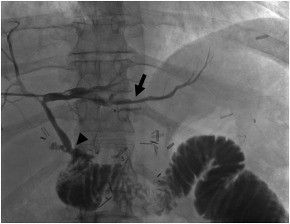Post written by Jad AbiMansour, MD, from the Division of Gastroenterology and Hepatology, Mayo Clinic, Rochester, Minnesota, USA.

We present the use of a preexisting percutaneous transhepatic biliary drain to distend the left biliary system and facilitate the completion of EUS-guided hepaticogastrostomy (EUS-HG), successfully internalizing the drain.
This case highlights a multidisciplinary, collaborative approach and a unique clinical scenario in which restoring physiologic enterohepatic circulation was clinically advantageous, preventing repeated hospitalizations for dehydration and malnutrition.
EUS-HG can provide effective biliary drainage in patients who fail or are not candidates for conventional ERCP and offers internal drainage in patients who would otherwise require percutaneous intervention.
In addition to liberating the patient from an inconvenient and cumbersome external device, this approach promotes physiologic flow of bile. Downsides include the need for routine stent exchange, and this should be weighed with potential benefits and pursued only after a nuanced discussion with the patient.
In conclusion, the decision to perform EUS-HG should ultimately be made after careful consideration of patient anatomy, clinical factors, and multidisciplinary discussion. The procedure can be technically challenging in patients without a dilated biliary tree. This case features a potential approach in patients with preexisting drains.
 Cholangiogram obtained through a percutaneous transhepatic biliary drain highlighting diffuse intrahepatic strictures (arrow), a relatively patent hepaticojejunostomy, and contrast pooling in the biliary limb.
Cholangiogram obtained through a percutaneous transhepatic biliary drain highlighting diffuse intrahepatic strictures (arrow), a relatively patent hepaticojejunostomy, and contrast pooling in the biliary limb.
Read the full article online.
The information presented in Endoscopedia reflects the opinions of the authors and does not represent the position of the American Society for Gastrointestinal Endoscopy (ASGE). ASGE expressly disclaims any warranties or guarantees, expressed or implied, and is not liable for damages of any kind in connection with the material, information, or procedures set forth.
